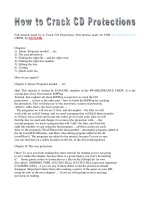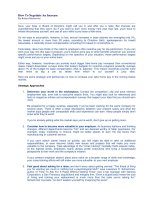How to Display Data- P4 pptx
Bạn đang xem bản rút gọn của tài liệu. Xem và tải ngay bản đầy đủ của tài liệu tại đây (129.16 KB, 5 trang )
Introduction to data display 7
1.7 Table or graph?
A fundamental point to consider is whether to use a table or graph (see
Box 1.4). We defi ne a table as a display of numbers in a rectangular grid,
and a graph or chart as a picture in which the numbers are represented by
points or lines. Plotting data is a useful fi rst stage to any analysis and will
show extreme observations together with any discernible patterns. In addi-
tion the relative sizes of categories are easier to see in a diagram (bar chart
or pie chart) than in a table. Graphs are useful as they can be assimilated
quickly, and are particularly helpful when presenting information to an
audience. Tables can be useful for displaying information about many
variables at once, while graphs can be useful for showing multiple observa-
tions on groups or individuals. Although there are no hard and fast rules
about when to use a graph and when to use a table, in the context of a
report or a paper it is often best to use tables so that the reader can scrut-
inise the numbers directly. Thus, for a talk or presentation, Figure 1.2 would
be a good method of displaying the data. However, for a printed report or
paper, Table 1.1b conveys the data more accurately and succinctly.
1.8 Software
No single package can draw all the graphs necessary for displaying data.
Simple graphs can be drawn in Microsoft Excel. However, you should be
aware that some of the default settings are not ideal (see Chapter 2). For
more complex graphs, any of the major statistical packages – STATA, SPSS
or SAS – are useful. S-Plus is particularly good for superimposing several
graphs into a single fi gure. In drawing the graphs for this book a variety
of packages were used, although many were drawn in the specialist pack-
age Sigmaplot (Systat Software Inc 24, Vista Centre, 50, Salisbury Road,
Hounslow, TW4 6JQ, London). Packages change regularly so we have not
given explicit instructions on how to draw individual graphs in particular
packages. The book simply outlines good practice for displaying data.
Box 1.4 Graph or table
Graph Table
Usually better in presentations Often better in papers
Can often show all the data Usually can only show summaries
Usually show only a few variables Better for multiple variables
8 How to Display Data
Summary
• The purpose of any attempt to present data and results, either in a presen-
tation or on paper is to communicate with an audience.
• In the following chapters key methods using both graphs and tables will
be outlined so that by the end of this book you should have the skills and
knowledge to display your data appropriately.
• In addition, you will be able to distinguish between bad graphs and good
graphs and know how to transform the former into the latter and you
should be able to distinguish between a bad table and a good table and be
able to transform the former into the latter.
• A variety of software packages is available for drawing graphs. In order to
draw all of the graphs outlined in this book you will need to use several
packages.
References
1 Freeman JV, Walters SJ. Examining relationships in quantitative data (inferential
statistics). In: Gerrish K, Lacey A, editors. The research process in nursing, 5th ed.
Oxford: Blackwell; 2006, pp. 454–74.
2 Altman DG, Bland JM. Presentation of numerical data. British Medical Journal
1996;312:572.
3 Tufte ER. The visual display of quantitative information. Cheshire, Connecticut:
Graphics Press; 1983.
4 Ehrenberg ASC. A primer in data reduction. Chichester: John Wiley & Sons; 2000.
5 Morrell CJ, Walters SJ, Dixon S, Collins K, Brereton LML, Peters J, et al. Cost effec-
tiveness of community leg ulcer clinic: randomised controlled trial. British Medical
Journal 1998;316:1487–91.
6 Bigwood S, Spore M. Presenting numbers, tables and charts. Oxford: Oxford
University Press; 2003.
7 Huff D. How to lie with statistics. London: Penguin Books; 1991.
9
Chapter 2 How to display data badly
2.1 Introduction
There are a great many ways in which data can be badly displayed and this
chapter outlines some of the more common errors. This topic is covered in
greater depth by Huff in his classic text ‘How to lie with Statistics’, in which
he lays out the numerous ways in which poorly displayed data can be used
to mislead.
1
A further useful reference is Wainer.
2
2.2 Amount of information
One of the easiest ways to display data badly is to display as little informa-
tion as possible. This includes not labelling axes and titles adequately, and
not giving units. In addition, information that is displayed can be obscured
by including unnecessary and distracting details.
Consider the following simple data set resulting from a survey of students
(Table 2.1).
Table 2.1 Height of 10 students
(in centimetres)
Men Women
175 179
180 160
171 165
175 170
185 174
A common way to display these data badly is to present the means for
each group and their associated standard errors using a bar chart with error
bars, so called ‘dynamite plunger plots’ as shown in Figure 2.1.
10 How to Display Data
This chart violates many of the recommendations of Chapter 1 and yet is
commonplace. While only four pieces of information are displayed (group
means and their standard errors) much ink is wasted drawing the bars. The
scale begins at the origin, so that the variability of the data is compressed
into a small area. The Y-axis is not clearly labelled as there is no indication
of the scale and no information about the number of observations in each
group. Most importantly for these data, the raw data are hidden behind a
summary statistic. It may be that the purpose of displaying these data is
to compare the group means, in which case a better way would be sim-
ply to report these statistics in the text. However, if the reason for display-
ing data such as these is to compare the spread of values in the two groups,
the standard errors for the individual means are of little use and you
are better just showing the actual data, using a dot plot as described in
Chapter 4.
It is possible to become even more obscure by using a three-dimensional
chart and vertical axis that does not start at zero as shown in Figure 2.2.
We have now succeeded in showing only two pieces of information (the
mean values of height for men and women) and also managed to obscure
them by gratuitously making the chart three dimensional. Furthermore, the
difference in mean height between the male and female students has been
exaggerated by making the Y-axis start at 164 cm.
200
180
160
140
120
100
80
60
40
20
0
MenWomen
Figure 2.1 Mean and standard error bars of data in Table 2.1 displayed using a bar
chart.
How to display data badly 11
2.3 Suppress the origin or change the baseline
A frequent means of exaggerating trends over time is to suppress the origin.
This type of error creates the ‘gee-whiz’ graph for showing trends.
1
Table 2.2
contains the age-standardised death rates for women, in England and Wales,
from lung cancer for the years 1998–2004.
3
By starting the Y-axis at 282
deaths per million, a relatively small decrease from 291 to 284 deaths per mil-
lion looks very dramatic. The type of graph displayed in Figure 2.3 is common
and shows an apparently large change, whereas the actual decrease represents
a fall of about 2.4% over a 7-year period.
164
MenWomen
166
168
170
172
174
176
178
Figure 2.2 Three-dimensional bar chart of data in Table 2.1.
Table 2.2 Age-standardised death rates from lung cancer (per million) for
women in England and Wales for the years 1998–2004, using the European
Standard Population
3
Year 1998 1999 2000 2001 2002 2003 2004
Death rate 291 289 285 283 284 285 284









